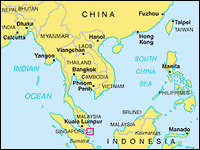Is Singapore About to Become a U.S. Military Hub Against China?

Singapore, a small but well-armed island nation in Southeast Asia, with 72,000 troops in the army, was approved by the United States in early January 2020 to acquire 12 F-35Bs, along with necessary equipment such as spare engines, parts, electronics, equipment, and simulators, at a contract price of $2.75 billion. The Singaporean Air Force has 316 aircraft, 16 squadrons and 14,800 troops at four Air Force bases, with most of the offensive power being 40 F-15s and 60 F-16s. The Air Force is impressive but not so much compared to other regional and great powers. Singapore’s Defense Minister, Ng Eng Hen, emphasized that the American made war planes is intended to gradually replace the F-16 fighter that is now mostly used by the Singaporean Air Force – and this could be a gamechanger against Chinese interests in the region.
With Singapore’s acquisition of these aircraft, it could drastically change the arms balance in the South China Sea region where China and the U.S. are competing, and even beyond. This small island nation has a close alliance with the United States and has also joined the United Kingdom, Australia, New Zealand and Malaysia – all Commonwealth countries – in a military agreement known as the Five Powers Defence Arrangements. Singapore is also providing full support to the U.S. by allowing them use of the Paya Lebar Air Force Base, and U.S. warships can call at Sembawang Naval Base. The visits by U.S. Presidents Barack Obama and Donald Trump to the Paya Lebar base during their visit to the region also demonstrates Washington’s trust in Singapore and recognizes the critical geostrategic location of Singapore on international trades.
The Paya Lebar Air Base is home to 40 F-15s, and is also home to five aerial refuelling aircraft, the KC-130B. Changi East Air Base is equipped with 20 F-16s and four A330 MRTT aerial refuelling aircraft. The A330 MRTT’s are essentially a refuelling machine tied to a fighter. This greatly increases the radius of action. Not only can the F-35 be refuelled in the air, but it can also land on allied, especially American, aircraft carriers. For example, an American Wasp-class assault ship can support the F-35’s offensive actions.
Singapore is located on a junction of the Malacca Straits, a crucial sea lane in Southeast Asia that has about 50,000 mercantile ships pass through every year. The Malacca Straits, strategically and economically, is one of the most important sea lanes in the entire world, in equal importance to the Suez and Panama Canals. This is because the Malacca Straits is the main sea route connecting the Indian Ocean with the Pacific Ocean. The route runs along the southern shore of the island and Singapore controls the airspace above it, making it one of the most important sea lanes in the world, especially for international Chinese trade and the Belt and Road Initiative. It is for this reason that Singapore has become another flashpoint in the China-U.S. rivalry in the region as any blockage of this sea lane from Chinese ships will significantly impact China’s economy.
Although Singapore is more aligned with the U.S., its air force does not match its ambitions. However, the acquisition of the U.S.-made F-35’s aims to create the island country into a powerful Small Power in one of the most important geostrategic locations in the world. The F-35 creates many advantages in the Malacca Straits for the U.S. and Singapore. In the event of a war in the region the Straits could be closed to China, creating significant economic and logistical problems for China’s engagement with the rest of the world.
In this way, Singapore’s acquisition of modern aircraft means not only increased control of the Straits, which is critical for military and commercial navigation, but also the possibility for the U.S. and Singapore to quickly dispatching reinforcements to areas where potential combat in the South China Sea, Taiwan and the Korean Peninsula, could occur. With Singapore’s F-35B, the small island country can also appear in unexpected places all across the region to assist their American allies in anti-China operations.
It is likely that Washington is turning Singapore into an important U.S. hub in the region to enact and serve its interests and prevent the ever-increasing influence of China in Southeast Asia. With Singapore becoming a regional hub for the U.S. military, there is the possibility that the U.S. Air Force can reduce its reliance on air refuelling and facilitates in possible combat operations. Therefore, there is little doubt that Singapore’s latest acquisition of these powerful warplanes is to further consolidate Singapore’s alliance with the U.S. and Commonwealth states who overwhelmingly represent the Old Order of the world system and are yet to accept the realities of the Multipolar System.
*
Note to readers: please click the share buttons above or below. Forward this article to your email lists. Crosspost on your blog site, internet forums. etc.
This article was originally published on InfoBrics.
Paul Antonopoulos is a Research Fellow at the Center for Syncretic Studies.

